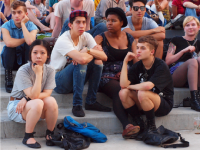Schools and the “instaself” Lives of Teens
As the app world encourages students to turn inward, schools can serve the critical role of reconnecting them to the world where they actually live.
In The End of Power, the book that Mark Zuckerberg chose to inaugurate his book club, Moises Naim writes, "Today, we ask not what we can do for our country, but what our country, employer, fast-food purveyor, or favorite airline can do for us." We live increasingly in a self-serving world. Consider this piece of evidence: A university in the UK is now offering a class on posting selfies.
The App Economy
The selfie stick is fast gaining in popularity. Katherine Rosman writes in The New York Times ("The Selfie Stick Takes Manhattan," January 2, 2015):
Snapchat and Instagram dominate social media, with people engaged in an "arms race" to gather followers. Panic set in when Kim Kardashian lost 1.3 million followers on Instagram.
Here are some examples of the "instaself" world:
- An Uber car arrives within minutes.
- Instacart delivers groceries within an hour.
- Amazon Prime guarantees delivery within two days.
- Pandora and Spotify customize and personalize music.
- Netflix tells you what movies and TV shows you want and need to watch.
You no longer have to work that hard to get what you want and need. Instead, with one magical click, you can have things delivered to your device or doorstep. Shopping malls are disappearing.
In his New York Times article ("Apps Everywhere, But No Unifying Link," January 5, 2015), Connor Dougherty writes:
He could be writing about the world teenagers are growing up in. The app world is moving at a dizzying pace. It's exciting, for sure, and very convenient. The app world is shrinking the world where we all live. More and more, teens are turning inward. The app economy is taking away public spaces.
Reconnecting the Private Universes
The "insta" life of teenagers presents challenges and opportunities for schools, which are the central public space where teens gather on a daily basis. Schools that hold core values at the center will be most successful in navigating the instaself world of teens.
On a recent morning, I heard a wonderful story shared by a woman walking into my school in Seattle. She was recovering from surgery and using a cane to help her walk steadily. The student 15-20 paces ahead of her entered the building and the door closed behind him. He'd noticed the woman on his way in, and she described how he seemed to pause. Then he walked back to the door, opened it, and held it for her.
She was impressed and heartened by this student's ability to notice her and demonstrate empathy. He could have been wearing headphones or looking a mobile device, but something made him pause and reflect. I'm not sure what it was, but I'd like to think that the doors of the school represented a gateway to a public space where certain core values of respect and responsibility are honored and held.
Schools should not abdicate their role in cultivating the positive power of public spaces, even with the proliferation of social media, selfies, and self-checkouts.
Yes, the inner world of teens may be aswirl in endless efforts to customize, personalize, individualize, and drown out the noise of others, yet there exist multiple opportunities to enlist teens in the small acts of connection to others, as the story illustrates. Schools are the "guardians of the galaxy" of all those instaselves. Inside these walls, public spaces can be preserved, and communities of positive peer pressure can flourish.
Even if you don't know what a selfie is, have never used Uber, don't have a Netflix account, or have never shopped on Amazon, that's OK because you're still in a position to instill the values that ask students to honor and recognize others, values that expect students to inquire what they can do to help others.
It's hard work for sure, and requires daily persistence and commitment. But it is so worth it.
